Mill tailings based composites as paste back fill in mines of U-bearing dolomitic limestone ore
Sndeep Pnchl,Desis De,T.Sreenivs
aDepartment of Mining Engineering,Indian Institute of Technology,Kharagpur,721302,India
bMineral Processing Division,Bhabha Atomic Research Centre,Hyderabad,500016,India
1.Introduction
Each year,a huge amount of mill tailings with different compositions is produced from processing plants throughout the world(Yilmaz et al.,2012).The surface disposal of the mine wastes is a serious problem due to its environmental impacts,occupation of largesurface-footprint,and excessive water inventory.For this,new technologies such as paste backfill in underground mines have emerged as alternative methods to surface disposal,facilitating the mining industry to reutilize such environmentally hazardous materials as support system and thereby minimizing or sometime eradicating harmful effects(Yilmaz et al.,2015a;Deng et al.,2017).Paste backfill improves ground support for mine structures with high recovery of ore bodies and at the same time,eliminates mine dewatering,reduces storage requirements for surface tailings and rehabilitation costs,thereby reduces the affiliated environmental risks(Brackebusch,1995;Sheshpari,2015;Jiang and Fall,2017).Paste backfill is generally considered to be a high-density nonsegregating mixture that contains 70-85%solids and at least 15%particles finer than 20μm to prevent settlement when transported through a pipeline for disposal(Klein and Simon,2006).The design requirements for the structural integrity of paste backfill are governed by physical,chemical and mineralogical properties of paste backfill ingredients(Benzaazoua et al.,1999;Fall and Nasir,2010).Benzaazoua et al.(2002)emphasized the strong dependency of geomechanical strength gain of paste backfill on the characteristics of three basic constituents,namely tailings,binder,and mixingwater.Yin et al.(2012)and Yılmaz and Ercikdi(2016)observed that increases in solid concentration and binder content can improve the mechanical properties of paste backfills but decrease the rheology thereof.Furthermore,Mohamed et al.(2002)evidenced that incorporation of additives(lime,f l yash and aluminum)in sulphide-rich tailings based paste backfill improved the mechanical strength and consistency,and reduced saturated hydraulic conductivity.In order to assess the suitability of granular mill tailings as paste backfill,its properties and behaviors are required to be determined independently(Yilmaz et al.,2011a).Studies are required for optimizing the behavior of cemented paste backfill(CPB)for ground support,environmental issues and cost aspects.
This study on mill tailings of a uranium ore deposit ascertains its suitability as paste backfill mainly for two reasons:(i)paucity of land for disposal and water for hydraulic filling,and(ii)ore extraction from hanging wall lode of ore body may not be possible without proper paste backfilling.The paper attempts to understand the rheological,geomechanical strength,and deformation behaviors of CPB composed of mill tailings of carbonate-rich uranium waste such that the surface foot print of the mill solid rejects is minimized in addition to providing sufficient support to side walls,roofs and pillars for mining additional ore.However,since CPB’s material properties are known to be time-dependent due to the progressive cement hydration reaction(Lu et al.,2017),the paper provides results of the above studies and establishes unique relationship between the hydration process and rheological and strength properties of CPB.The paste backfill technology is in nascent stage in India and the study reported here is the first attempt to characterize the carbonate-rich uranium processing waste as paste backfill material.It assumes further significance as the investigations provide pointers to handle huge volumes of mine rejects in countries where habitation is close to ore bodies.Apart from summarizing the various test procedures,the paper provides significant data related to the physical,chemical,rheological,and geotechnical behaviors of CPB for carbonate-rich mill tailings and will be helpful for future research findings.
2.Materials and methods
Physical,chemical,mineralogical,morphological,rheological,and geotechnical properties of paste backfill and its ingredients are studied on the tailings(leach residue)obtained during hydrometallurgical processing of a dolomitic limestone bearing uranium ore as per ASTM(American Society for Testing and Materials)and IS(Indian standard)methods.Similar methodologies for characterizing paste backfill and its constituents have been reported by several researchers(Yilmaz et al.,2007,2011a,b,2014a,b,2015a,b;Ghirian and Fall,2013,2014).It may be noted that the CPB’s parameters,i.e.water contentw,solid concentrationCw,binder contentBwand superplasticizer dosageSPwhich are used in subsequent sections of this paper,are calculated as follows(Koupouli et al.,2016):

whereMwateris the mass of water,Mdry-binderis the mass of dry binder,Mdry-solidis the mass of dry tailings and dry binder,andMSPis the mass of superplasticizer.
2.1.Tailings,binder and superplasticizer
The tailing samples under investigation have been collected from a dolomitic limestone bearing uranium ore processing mill located in south India(Gupta and Sarangi,2011).The samples are preserved in sealed plastic containers to prevent pore water loss and occurrence of oxidation prior to their subsequent usage in laboratory experiments.Before experiments,the tailing samples are homogenized by thoroughly mixing and sub-samples are prepared by coning and quartering.The other CPB ingredients used in this study are municipal tap water as mixing water,ordinary Portland cement(OPC)of 43 grade(IS:8112,2013)as binder,and polycarboxylate(PC)based superplasticizer(IS:9103,1999)as high-range water reducer admixture.
2.2.Physical characterization tests
The study encompasses laboratory experiments,mainly specific surface area,particle size distribution,specific gravity,saturated hydraulicconductivity (saturated permeability)and Proctor compaction test.specific surface area is evaluated as per(ASTM D6556-16,2016)by measuring nitrogen(N2)multi-point adsorption isotherms using Automated Gas Sorption Analyzer(Autosorb-1,Quantachrome Instruments)based on the BET(Brunauer,Emmett,and Teller)method.The particle size analysis is conducted using a Malvernparticle size analyzer(Mastersizer 2000 E Ver.5.20,UK).The specific gravity of tailings is determined according to IS:2720-Part 3(1980)standard.Saturated hydraulic conductivity of tailings is determined as per ASTM D5856-15(2015).To evaluate the optimum moisture content(OMC)and the maximum dry density(MDD),the Proctor compaction tests are performed as per ASTM D698-12e2(2012).
2.3.Chemical characterization tests
The chemical composition of the tailing samples is determined by wet chemical analysis and X-ray fluorescence(XRF)spectrometer(Axios,PANalytical).In addition to this,energy-dispersive X-ray spectroscopy(EDX)coupled to scanning electron microscopy(SEM)is also used for the similar purpose.ZEISS EVO 60(Carl ZEISS SMT,Germany)SEM is used to characterize the microstructure and texture of the tailing sample.Secondary electron(SE)imaging mode is used for creating images.EDS detector(INCAPentaFET-x3,Oxford Instrument,UK)probe coupled to the SEM is used to aid the qualitative and quantitative elemental composition partial analysis of the tailings.
2.4.Mineralogical and morphological characterization tests
Due to the high lyvariable nature of the local geology in the mine site,it is important to assess the mineralogical properties of tailings.Mineralogy of tailings significantly influences the rate of strength gain and final strength of backfill(Potvin et al.,2005).In this study,X-ray diffraction(XRD)spectrometer(PW:3040/60 X’pert PRO,PANalytical,Netherlands)is used to determine the mineralogical composition of the tailings.In addition,ZEISS MERLIN field emission SEM(FE-SEM)has been used for studying morphology of developed paste backfill.
2.5.Determination of pH value of tailings and leachate of CPB
The pH value is measured as per IS:2720-Part 26(1987)by a Benchtop meter(Thermo Scientific Orion VERSA STAR)coupled with pH electrode(Orion,8172BNWP,ROSS sure-f l ow).
2.6.Rheological characterization tests
Rheology tests on the slurry are necessary for evaluation of the colloidal characteristics and pipeline transport potential of uncemented/cemented paste backfill.These tests are conducted for(i)estimation of slump height using slump cone tests,and(ii)determination of yield stress using rheometer.
2.6.1.Slump
The slump height determination allows characterizing the material’s consistency in terms of transportability/pumpability.Slump measured by standard slump cone test in accordance with ASTM C143/C143M-12(2012)is dependent on both yield shear stress and density of the paste backfill,which can vary with changes in solids specific gravity,particle-size distribution,and chemical composition.
2.6.2.Yield stress
Paste backfill behaves as non-Newtonian Bingham plastic fluid since it requires an initial stress(yield shear stress)to commence the irreversible plug f l ow and the yield shear stress is exponentially proportional to the solid concentration of the fluid(Sofrá and Boger,2002;Clayton et al.,2003).Slump height parameter alone does not fully indicate the rheological behavior of paste backfill(Clayton et al.,2003).Furthermore,slump is a single shear test parameter while pumping involves a range of shear rates.Hence,yield shear stress becomes the essential consistency parameter to describe the rheology of paste backfill(Jiang et al.,2016).In this study,yield stress has been determined using rotational rheometer(Anton Paar RheolabQC)by stress growth technique in controlled shear-rate(CSR)mode in combination with vane geometry which involves shearing the material at a low and constant shear rate over time,and the maximum shear stress in the stress time profile is treated as yield stress.It is reported that the yield stress of the material is the maximum shear stress that a material offers at low rate shearing(Liddel and Boger,1996),because,at a higher shear rate,significant viscous resistance together with instrument inertia,quick structural breakdown and inadequate damping can result in erroneous torque and concomitant yield stress measurement.The geometry of vane tool,which is four thin blades arranged at 90°around a small cylindrical shaft,eradicates any wall slip effect,and inhibits significant disturbance to the sample caused by the immersion of the vane into the sample before any measurement,and thus allows the paste to yield under static condition within the material itself.The yield shear stress τ(Pa)has been reckoned using Eqs.(5)and(6)(Nguyen and Boger,1983):

whereTmaxis the maximum torque(N m),Dis the diameter of the vane(m),andHis the length of the vane(m).
In this study,a new methodology has been proposed to estimate the yield stress of CPB.The CPB of a given composition is tested using the rheometer for establishing shear stress versus shearing time relationship for a constant shear strain rate and a given hydration time.This process is continued for shear strain rates of 0.05 s-1,0.1 s-1,0.15 s-1and 0.2 s-1for the same hydration time and CPB composition.A new relationship is determined in which yield stress of CPB is defined as the shear stress at zero shearing rate.The hydration time is chosen at an interval of 15 min counted from the initial contact of water with OPC of the CPB up to 180 min.We assume that rheology test will be performed afterhtmin of hydration time.The CPB sample is kept undisturbed up toht-2 min and it is subjected to strong preshear for the next 1 min.Then CPB loaded container is set with the rheometer and left undisturbed for another 1 min.The rheology test is then conducted for 3 min fromhtmin toht+3 min.A moist cloth is covered around the CPB loaded sample holder,providing a water saturated atmosphere over the CPB sample and thereby preventing moisture loss due to evaporation.
2.7.Geotechnical tests
The required ingredients of the paste backfill batch are measured in accordance with the desired paste backfill scheme.Then the tailing,OPC,tap water,and superplasticizer are blended and homogenized using a mechanical mixer until a desired paste backfill mixture with smooth consistency is obtained.After mixing,the designed paste is subjected to slump cone test based on ASTM C143/C143M-12(2012)as mentioned earlier to obtain the slump height.Then the paste backfill mixture is poured into PVC plastic cylindrical molds of appropriate dimensions.Thereafter,these samples are put in the humidifier which mimics typical curing conditions of underground mine stope.In humidifier,samples are allowed to drain any excess water and they hydrate in molds for 24 h.Subsequently they are extruded from their molds and again put back in the humidifier till standard curing(hydration)period.
2.7.1.Uniaxial compressive strength(UCS)test
The samples for UCS test are prepared with height-to-diameter ratio equal to two.After different curing periods,samples of uncemented paste backfill and CPBs are subjected to UCS tests according to ASTM C39/C39M-14a(2014).Both ends of the samples are first rectified to obtain plane surfaces so that the platens have the f i rm contact with the samples,and uniform distribution of the applied load is ensured.Samples are placed between the platens of a servo-controlled universal testing machine and compressive load is applied with a displacement rate of 1.2 mm/min.In this study,all cured samples are prepared in quadruplicate.The general guideline for UCS values of filling material is reported by Grice(1998),Bloss(2002),and Belem and Benzaazoua(2008a).For filling mine void and eliminating liquefaction at the early ages,a UCS between 150 kPa and 300 kPa is required.Target mechanical strength of paste backfill mass after 28 d curing is up to 1000 kPa to assure its structural stability in pillar recovery during open stoping operations,when free-standing wall faces are exposed.However,when the key function of paste backfill is in roof supporting,the UCS higher than 4000 kPa becomes essential.Furthermore,the elastic modulus of backfill ranges generally from 100 MPa to 1200 MPa.
2.7.2.Shear strength test
The shear strength parameters,i.e.cohesion and angle of internal friction,are determined by unconsolidated undrained(UU)triaxial compression test in accordance with ASTM D2850-15(2015)for uncemented paste backfill and CPBs for different curing periods.The triaxial machine consists of a pressure cell assembly and equipment for loading and measuring the load and deformation.Cylindrical samples as discussed in the UCS tests are inserted in a thin seamless rubber membrane and sealed to prevent the lateral ingress of water and placed in the pressure cell.A constant lateral pressure is applied to the sample by a compressed air setup.The pressure gage measures the applied water pressure in the cell.Then a compressive load is gradually applied to the cell with a displacement rate of 1.2 mm/min until shearing takes place in the sample.All CPB samples are tested in three different confining stresses(σ3),i.e.50 kPa,100 kPa and 150 kPa for CPB having 4%OPC and 100 kPa,200 kPa and 300 kPa for both CPB having 6%and 8%OPC.
3.Results and discussion
3.1.Evaluation of the physical characterization
Average specific surface area of tailings is found to be 1.515 m2/g which can be ascribed to the large amount of fine particles in the tailings.It is observed that 47%of the tailings is finer than 20μm(see Fig. 1 and Table 1)which ensures the substantial surface area of the particles to provide adequate surface tension to enable the solid grains to hold water and to provide a very thin permanent lubricating film forming paste.Generally,47%of particles finer than 20μm categorize tailings as medium size grained particles which appear to have lower mechanical strength grade(Landriault,1995).It has been reported that the maximum UCS can be achieved if the backfill sample contains 47-53%of fines(Fall et al.,2004).Fig. 1 presents a typical particle size distribution curve of tailings.It can be seen that around 77.5%of tailings consist of large silt-size particles(2-75 μm),while clay-size(<2 μm)and sand-size(75μm-4.75 mm)are around 4.5%and 18%,respectively.In addition,granular material is known to be well-graded if coefficient of uniformity,Cu(=D60/D10)is of 4-6 and the coefficient of curvature,CC(=D302/(D60D10))is in between 1 and 3(Ercikdi et al.,2013).In this study,tailing is found to be poorly-graded with an average coefficient of uniformityCuof 9.44 and an average coefficient of curvatureCCof 0.96 as summarized in Table 1.specific gravity of tailings is found to be 2.83.This value is consistent with the specific gravity of dolomite mineral which is a major rockforming mineral in the tailings discussed in Section 3.3.The specific gravity of the tailings influences the solid mass concentration of paste backfill for a specific slump(Yilmaz et al.,2007).The saturated hydraulic conductivity of tailings is found to vary from 3.8×10-5cm/s to 5×10-5cm/s,with an average value of 4.4×10-5cm/s(see Fig. 2)which is similar to the order of saturated hydraulic conductivity of general hard rock mines generated tailings across mining industry worldwide(Aubertin et al.,1996).In Fig. 2,Ais the cross-sectional area of the fill(cm2);Lis the length of filling(cm);ais the internal X-sectional area of the capillary tube(cm2);t= (t1-t2)is the time interval(s)for the head to fall fromh1toh2;h1is the initial head of water at timet1in the initial head of water in the capillary tube(cm),measured above the outlet;andh2is the final head of water at time in the capillary tube(cm),measured above the outlet.

Fig. 1.Particle size distribution of the tailings.
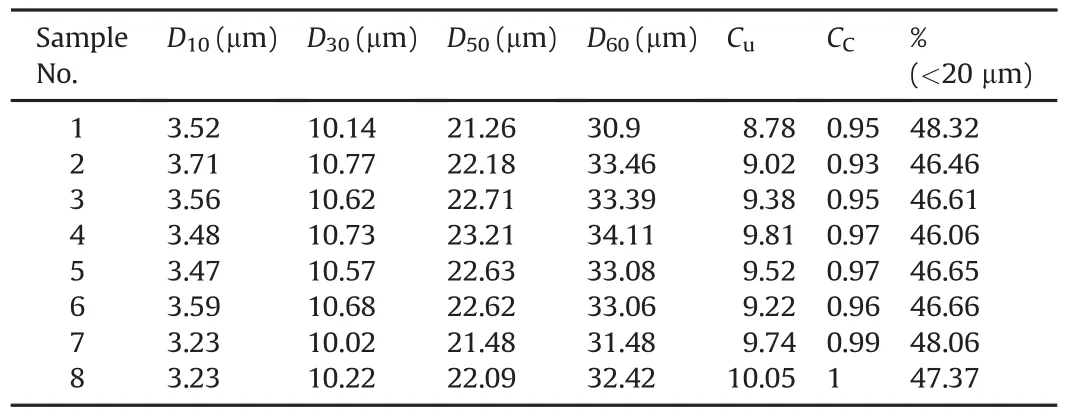
Table 1Summary of particle size distribution analyses of tailings.

Fig. 2.Saturated hydraulic conductivity of tailings.

Fig. 3.Time-dependent variation of saturated hydraulic conductivity of CPB.

Fig. 4.Standard Proctor compaction test curve for tailings.

Table 2Partial chemical composition of tailings(unit:%).

Table 3Chemical composition of tailings and binder(OPC)by XRF analysis(unit:%).
From geotechnical standpoint,this tailings belongs to low degree of permeability(Lambe and Whitman,2008),and hence it is considered to be suitable for paste backfill mixture.Such low permeability is ascribed to the high amount of fines as well as elongated and irregular particle shape(discussed in Section 3.2)having rough surface texture(Head and Epps,2011).Lower permeability reduces leaching of toxic and heavy elements from the paste backfill into receiving water bodies.Moreover,as the depth of tailings in the form of CPB deposition in underground stope increases,its saturated permeability further decreases owing to reduction in quantum of pore volume as a result of combined effect of self-desiccation process and self-weight consolidation(Fall et al.,2009;Alakangas et al.,2013).The saturated permeability of CPB also decreases with hydration time.Fig. 3 illustrates the drop in saturated hydraulic conductivity as logarithmic inverse function with hydration time for the CBPs(Cw:78%,Bw:4%,SP:1%)and (Cw:78%,Bw:6%,SP:1%).
The total reduction in permeability is reckoned to be 28%and 62%for aforementioned CPBs havingBwvalues of 4%and 6%respectively,over the hydration time of 14 d.Due to the decrease in saturated permeability,leachate generation is periodically reduced,which concomitantly decreases its adverse effect on receiving water and biota.The reason for such drop in saturated hydraulic conductivity is the continuous evolution of cement hydration products of mainly calcium silicate hydrate(CSH),calcium hydroxide(CH)and ettringite,which progressively refines the microstructure of CPB by blocking the interconnected pores and reducing porosity as discussed in Section 3.3.The loss of saturated permeability in CPB with higher dosage of binder content is attributed to the higher amount of cement hydrates therein.This phenomenon is also documented by XRD and SEM studies which are discussed in Section 3.3.Fig. 4 depicts the results of Proctor compaction test.OMC is found to vary from 14.27%to 11.65%and the corresponding MDD varies from 1873 kg/m3to 1954 kg/m3,which is fairly comparable with the typical results of hard rock mill tailings.The average effective porosity and void ratio for the optimum condition are close to 32.8%and 0.49,respectively.
3.2.Evaluation of the chemical characterization
Table2 shows the summary of wet chemical analysis of tailings.It can be seen that tailings is dominated by calcium oxide,CaO(22.6%),magnesium oxide,MgO(14.04%),and silicon dioxide,SiO2(10.27%).Minor quantities of aluminum oxide,Al2O3(2.89%),are detected as well as trace amounts of copper,molybdenum,manganese,potassium,sodium,nickel,titanium,and manganese oxides.
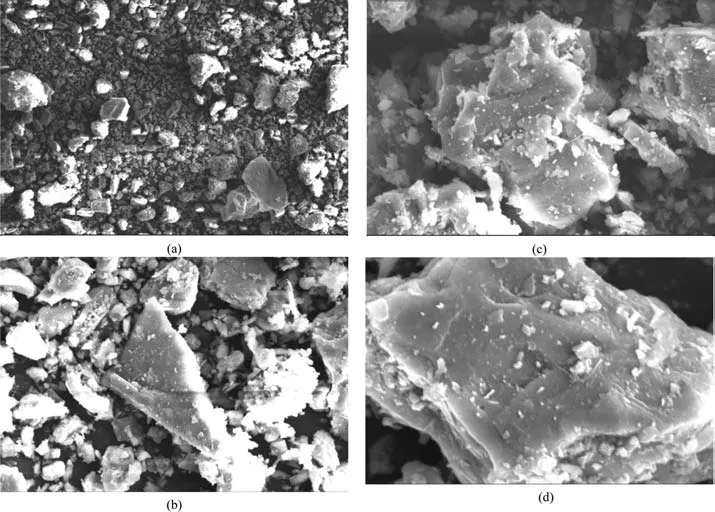
Fig. 5.SEM micrographs of tailings(a)at×500 magnification,(b)at×3000 magnification,(c)at×5000 magnification,and(d)at×10,000 magnification.

Fig. 6.EDX spectra of tailings.
Moreover,chemical compositions of the studied tailings and binder(OPC)are also determined by XRF analysis,as given in Table 3.These results reflect that tailings consist of high content of calcium oxide,magnesium oxide,and silicon oxide,whose presence can be attributed to the hosted dolomitic limestone rock.The high percent of lime(CaO)in the tailings,which is in fair agreement with XRD results,offers cementitious property to the paste backfill in the presence of SiO2,Al2O3and water.OPC appears to be rich in CaO,SiO2and Al2O3.SO3found in OPC is due to gypsum added in OPC during its manufacturing to control the setting time or f l ash setting.It is noted that though the elements are presented in form of oxides,they nonetheless may not be presented in the tailings as oxides.Furthermore,SEM micrographs(Fig. 5)reveal an indication of the angularity of tailings particles.
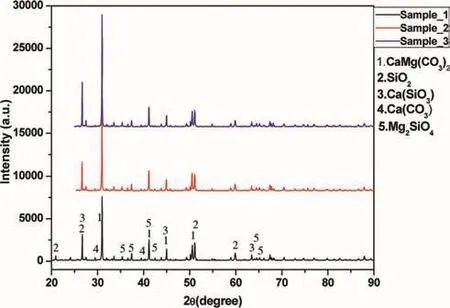
Fig. 7.X-ray diffractograms of tailings.Here a.u.stands for arbitrary unit;2θis diffraction angle of x-ray beam.
From Fig. 5,it can be observed that substantial amount of fine particles is available in the tailings.This fact is also verified by particle size distribution analysis as shown in Fig. 1.It is fairly apparent that unlike natural geological material,tailing particles are angular in shape due to the mineral comminution process.This result matches with those reported by Powers(1953)and Garga and McKay(1984).Such angular-shaped particles may not assist in f l ow ability of paste backfill and affect the wear rate of pipe during transportation.Nevertheless they offer high friction angle due to higher relative density(Holubec and D’appolonia,1973;Chan and Page,1997).Clough et al.(1989)reported that the effect of binder on angular particles is stronger than rounded particles.The peak elements shown in Fig. 6 signify the existence of the minerals in tailings which are also substantiated by XRD(Fig. 7)and chemical analysis(see Tables 2 and 3).As expected,the EDX results(Table 4)show higher count of calcium element which signifies the higher proportion of calcium element in the tailings.

Table 4EDX results of tailings.
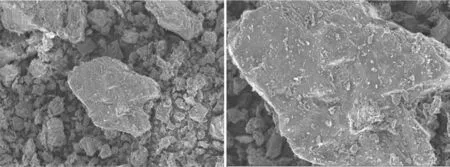
Fig. 8.SEM micrographs of uncemented paste backfill after 28 d.
3.3.Evaluation of the mineralogical and morphological characterization
Fig. 7 shows the XRD quantification results of tailing mineralogy.The XRD peak intensities(count values)of the tailings are very clear and sharp,suggesting that crystalline phases are the main constituents of the mill tailings.
The X-ray diffractograms reveal that the tailings consist of dolomite(CaMg(CO3)2),quartz(SiO2),calcite(CaCO3),Forsterite(Mg2SiO4)and wollastonite(CaSiO3)minerals.Brackebusch(1995)reported that calcite,clay,silicate or similar highly-colloidal,high water-retention minerals increase water retention of tailings.Due to this fact,these minerals may reduce the strength of paste backfill(Yilmaz,2010).Furthermore,calcium acts as acid neutralizer,and offers cementitious properties which aid in cohesion development of CPB.No trace of sulphide mineral,such as Pyrite,has been identified in the studied tailings.This is consistent with the low percentage of sulfate expressed as a percentage of SO3as an ingredient of OPC determined by XRF test in the subsequent section.Fig. 8 shows the morphology of uncemented paste backfill which affirms the angularity of tailings particles.

Fig. 9.SEM micrographs of CPB(a)after 1 d of hydration,(b)after 7 d of hydration,and(c)after 28 d of hydration.
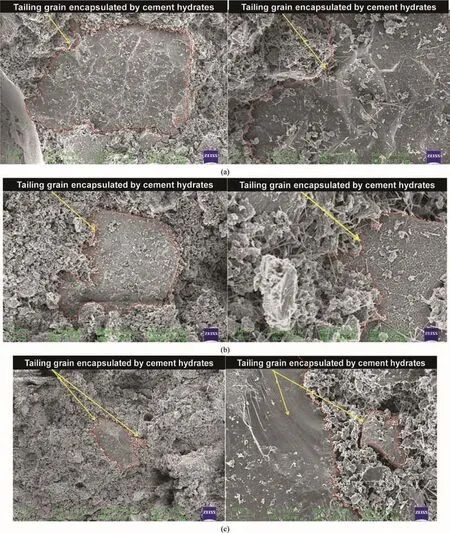
Fig. 10.SEM micrographs of CPB(a)after 7 d of hydration,(b)after 28 d of hydration,and(c)after 120 d of hydration.
After hydration durations of 1 d,7 d,28 d and 120 d,CPBs(Cw:78%,Bw:6%)are oven-dried to examine texture and morphologyas well as cement hydration products within the CPB,as shown in Fig. 9.

Table 5Standard slump cone test results.
It is clear from the FE-SEM tests that plate-like CH(calcium hydrate)and foil-like or honeycomb-like CSH gel are generated from the quick hydration of tri-calcium silicate(3CaO·SiO2).Similarly,needle-shaped ettringite crystals are evolved from the hydration of aluminates after curing time of 1 d as shown in Fig. 9a(Sun et al.,2015).Relatively longer size and prism-shaped CH and ettringite crystal are observed after 7 d of hydration.It can be seen that all cement hydration products gradually tend to encapsulate the tailing particles in the CPB matrix as demonstrated in Fig. 9.However,such coating is more pronounced in the long term due to the formation of cementitious gel(CSH).Fig. 10 depicts the encapsulation of tailing grains by densely-packed cement hydrates for different hydration times.
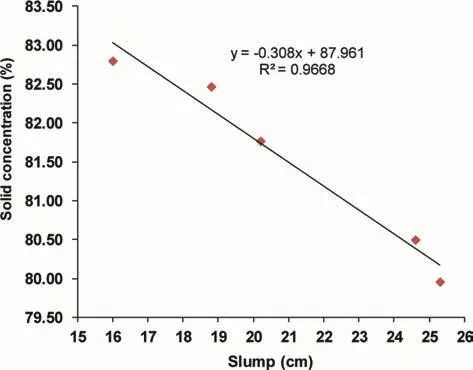
Fig. 11.Solid concentration versus standard slump.
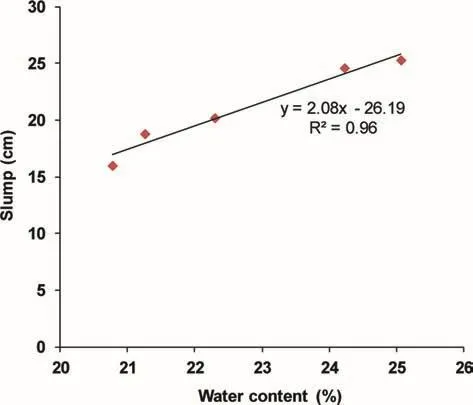
Fig. 12.Standard slump versus water content.
The gain in strength(discussed in Section 3.6)of CPB samples in the short term is mostly ascribed to the needle-shaped ettringite and plate-like CH crystal while for the long term,it is due to CSH gel.Thus,crystallinity of hydration products and degree of hydration reaction dictate the evolution of mechanical strength of CPB over hydration period(Fu et al.,2016).
3.4.Evaluation of pH value of tailings and leachate of CPB
The average pH value of tailings and mixing water is found to be 9.9 and 8.4,respectively.In addition,leachate of CPB(Cw:78%,Bw:6%,SP:1%)is collected by permeability test in accordance with ASTM D5856-15(2015).The observed pH values of leachate effluents emanated from CPB sample,after curing times of 3 d,5 d,7 d,and 14 d,are 13.2,12.9,12.5 and 12,respectively,which reflects a high alkaline environment within the CPB matrix.The higher pH value in leachate is attributed to high content of calcium in tailings and unreacted cement,which also assists in reducing the solubility and concentration of various elements in the effluents by maintaining alkaline environment therein.The decrease in pH value of leachate with hydration time may be attributed to the reduction in available calcium concentration due to evolution of hydration products,i.e.ettringite and CSH and CH compounds over curing time.Generally,sulphidic tailings based paste backfill stabilized with OPC tend to lose their strength at the long term due to sulfate attack phenomenon in which the pH value of paste backfill is lower than 7.However,several researchers have reported that the pH value of sulphidic tailings based CPB can be increased over curing time by incorporating different admixtures(e.g.marble waste,alkali-activated slag,ferrous slag,cement kiln dust and f l y ash),which concomitantly enhances their buffering potential and mechanical strength(Hassani et al.,2001;Tariq and Nehdi,2007;Cihangir et al.,2015;Ercikdi et al.,2015).

Fig. 13.A general view of developed CPBs with(a)slump of 25 cm and(b)slump of 19 cm.
3.5.Evaluation of the rheological properties

Fig. 14.Yield shear stress versus hydration time plot.

Fig. 15.Yield shear stress with regard to shear strain rate.
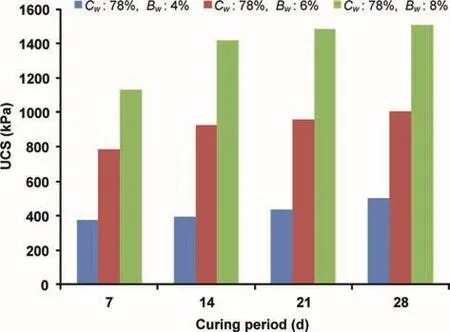
Fig. 16.influence of binder dosage on UCS of CPB at different curing periods.

Fig. 17.Mohr-Coulomb failure envelopes from the UU triaxial tests of CPBs after 28 d curing.

Table 6Results of UCS and UU triaxial tests.
Table 5 lists the results of slump test conducted on uncemented paste of different solid concentrations.It can be seen that at 79.96%solid concentration,slump is about 25.3 cm,which can be considered to be too thin.Such paste having higher slump and lower solid concentration necessitates lower pumping pressure due to less resistance to f l ow during its transportation through pipelines.However,it may have sedimentation problem unless adequate f l ow velocity is maintained in pipeline network(Brackebusch,1995).Moreover,when thin paste is placed in the stopes,it may require longer curing time for its drying and high porosity may result in lower geomechanical strength and durability(Kwak et al.,2005;Ercikdi et al.,2017).On the other side,at 82.8%solid concentration,slump of 16 cm means a thick paste.Such thick paste having high solid concentration usually yields higher geomechanical strength due to the reduction in capillary porosity.On the contrary,it may clog the pipeline during its transportation and necessitate costly positive displacement pumps to cater for excessive pumping energy(Ouattara et al.,2017).The ideal standard slump for good workability of paste backfill ranges from 150 mm to 250 mm(Landriault,1995).However,optimum slump for underground paste backfill systems generally lies between 178 mm and 203 mm(Belem and Benzaazoua,2008b).Fig. 11 indicates the inverse linear relationship between solid concentration and slump of paste backfill.
It can be interpreted from Fig. 12 that every 1%change in water content results in 2.08 cm thickness of change in slump of uncemented paste.Thus rheology of developed paste seems to be very sensitive to water content and in such cases,the ‘batch system’for mixing paste to subsequently transfer into a hopper for continuous distribution in the mine is practiced.The consistency of studied non-Newtonian CPB is having slump heights of 19 cm and 16 cm as shown in Fig. 13.
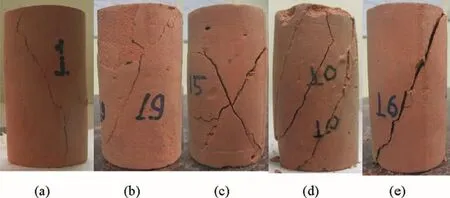
Fig. 18.Sample failure modes during UCS(a and b)and UU triaxial tests(c,d and e).
Fig. 14 presents a typical logarithmic behavior of yield shear stress with regard to hydration time at different shear strain rates for designed CPB specimens(Cw:78%,Bw:4%,SP:1% ).From Fig. 15,it can be interpreted that yield shear stress can be as low as 52.04 Pa after 15 min of hydration time to as high as 382.8 Pa for hydration time of 75 min.This result denotes that pressure loss in the pipe may be varied at different locations over the length of pipeline if the developed CPB travels a long distance before it is placed in an underground mine.
3.6.Evaluation of the geotechnical tests
Table 6 partly summarizes the UCS obtained from uncemented paste backfill as well as CPBs for different curing periods.It can be observed from Table 6 that the average UCS of tailings based uncemented paste backfill is about 396 kPa.Table 6 and Fig. 16 also give the UCS results of CPBs having three dosages of OPC,i.e.4%,6%and 8%as fraction of dry mill tailings.
It can be seen that the UCS values are significantly improved after adding OPC.It is evident that the gain in UCS after 28 d curing time of CPB samples,with 4%,6%,and 8%OPC,are 26%,153%and 280%,respectively,as compared with the UCS of paste backfill without cement.Moreover,data clearly indicate that the UCS follows increasing trend during different curing periods for all designed CPBs.This is a clear evidence of progressive development of cement hydration products in CPBs.Angle of internal friction and cohesion are estimated using Mohr-Coulomb failure criterion as shown in Fig. 17 and are given in Table 6.
It is observed that cohesion values are significantly varied between different paste backfill samples,but the increasing trends with binder dosage and curing time seem to be pronounced.The angle of internal friction ranged between 28°and 39°for the discussed paste backfills.The modes of sample failure(simple and multiple shearing)during the UCS and UU triaxial tests are shown in Fig. 18.
Samples that failed in other modes(e.g.simple extension and multiple fractures)are rejected since these failure modes affect the resultant strength of the samples.
4.Conclusions
Over the last few decades,application of paste backfill increases throughout the world since high volume of solids can be placed underground as compared to conventional hydraulic fill.However,before application of paste backfill to mines,various physical and chemical properties of mill tailings and engineering properties of CPB need to be determined for evaluation of paste backfill mixture for ensuring static and dynamic stability requirements as well as environmental acceptance.This paper details the investigation results of engineering properties as well as physical and chemical characteristics of tailings generated during hydrometallurgical processing of a uranium ore hosted on carbonate matrix.The tailings have been found to be suitable for paste backfilling as the granulometric analysis indicated significant presence of fine size particles.
The angularity of tailing particles aids in the shear strength of paste backfill since they offer high friction angle.The mineralogical and chemical analyses of the tailings confirmed the dominance of calcium oxide and magnesium oxide therein.The morphological analysis of CPB demonstrated the phenomenon behind UCS development and the loss of permeability of CPB over the curing time due to the formation of cement hydration products.The leachate emanated from CPB over the curing time appeared with alkaline which ensured the absence of any sulphide mineral oxidation and concomitant acid leaching from CPB.Standard slump cone tests indicate that the rheology of paste backfill is very sensitive to water content.
There exists a strong correlation of yield stress with shear rate and hydration time of CPB.It is observed that for higher shear rate,the yield stress is found to be higher for a specific hydration time.Likewise,for longer hydration time,the yield stress is also higher for a given shear rate.This observation suggests the occurrence of continuous rising friction losses across pipeline reticulation network during pumping of CPB for underground filling.After 28 d curing time,the UCS and cohesion values of paste backfill of 0%,4%,6%and 8%cement are 396 kPa and 98 kPa,501 kPa and 139 kPa,1005 kPa and 320 kPa,and 1505 kPa and 413 kPa,respectively.The CPB developed in this study is suitable for supporting mine roof and side walls and aids in enhancing the volume of ore to be mined with maximum safety of the underground workings.
Conflicts of interest
The authors wish to confirm that there are no known Conflicts of interest associated with this publication and there has been no significant financial support for this work that could have influenced its outcome.
Acknowledgements
The authors are extremely grateful and sincerely acknowledge the guidance,help in sampling,encouragement and consistent involvement of Mr.D.Acharya,Mr.P.K.Parhi of UCIL,Jaduguda and Mr.K.K.Rao of UCIL during this work.Dr.Deb and Mr.Panchal are also thankful to the Department of Atomic Energy(DAE),Government of India,for providing financial assistance(BARC/IFB/IITKHARAGPUR/295,Dt.18-03-2013)during this research work.
Alakangas L,Dagli D,Knutsson S.Literature review on potential geochemical and geotechnical effects of adopting paste technology under cold climate conditions.Luleå University of Technology;2013.
ASTM C143/C143M-12.Standard test method for slump of hydraulic cement concrete.ASTM 2012.
ASTM C39/C39M-14a.Standard test method for compressive strength of cylindrical concrete specimens.ASTM 2014.
ASTM D2850-15.Standard test method for unconsolidated-undrained triaxial compression test on cohesive soils.ASTM 2015.
ASTM D5856-15.Standard test method for measurement of hydraulic conductivity of porous material using a rigid-wall,compaction-mold permeameter.ASTM 2015.
ASTM D6556-16.Standard test method for carbon black-total and external surface area by nitrogen adsorption.ASTM 2016.
ASTM D698-12e2.Standard test methods for laboratory compaction characteristics of soil using standard effort.ASTM 2012.
Aubertin M,Bussiere B,Chapuis RP.Hydraulic conductivity of homogenized tailings from hard rock mines.Canadian Geotechnical Journal 1996;33(3):470-82.
Belem T,Benzaazoua M.Design and application of underground mine paste backfill technology.Geotechnical and Geological Engineering 2008a;26(2):147-74.
Belem T,Benzaazoua M.Predictive models for prefeasibility cemented paste backfill mix design.In:Proceedings of the 3rd international conference on post-mining;2008.
Benzaazoua M,Ouellet J,Servant S,Newman P,Verburg R.Cementitious backfill with high sulfur content physical,chemical,and mineralogical characterization.Cement and Concrete Research 1999;29(5):719-25.
Benzaazoua M,Belem T,Bussiere B.Chemical factors that influence the performance of mine sulphidic paste backfill.Cement and Concrete Research 2002;32(7):1133-44.
Bloss M.Below ground disposal(mine backfill).In:Jewell RJ,Fourie AB,Lord ER,editors.Paste and thickened tailings:a guide.Nedlands,Western Australia:University of Western Australia;2002.p.103-26.
Brackebusch FW.Basics of paste backfill systems.International Journal of Rock Mechanics and Mining Sciences and Geomechanics Abstracts 1995;32(3).A122.
Chan LCY,Page NW.Particle fractal and load effects on internal friction in powders.Powder Technology 1997;90(3):259-66.
Cihangir F,Ercikdi B,Kesimal A,Deveci H,Erdemir F.Paste backfill of high-sulphide mill tailings using alkali-activated blast furnace slag:effect of activator nature,concentration and slag properties.Minerals Engineering 2015;83:117-27.
Clayton S,Grice TG,Boger DV.Analysis of the slump test for on-site yield stress measurement of mineral suspensions.International Journal of Mineral Processing 2003;70(1-4):3-21.https://doi.org/10.1016/S0301-7516(02)00148-5.
Clough GW,Iwabuchi J,Rad NS,Kuppusamy T.In fl uence of cementation on liquefaction of sands.Journal of Geotechnical Engineering 1989;115(8):1102-17.
Deng DQ,Liu L,Yao ZL,Song KIL,Lao DZ.A practice of ultra- fine tailings disposal as fi lling material in a gold mine.Journal of Environmental Management 2017;196:100-˙9.
Ercikdi B,Baki H,Izki M.Effect of desliming of sulphide-rich mill tailings on the long-term strength of cemented paste backfill.Journal of Environmental Management 2013;115:5-13.
Ercikdi B,Külekci G,Yılmaz T.Utilization of granulated marble wastes and waste bricks as mineral admixture in cemented paste backfill of sulphide-rich tailings.Construction and Building Materials 2015;93:573-83.
Ercikdi B,Cihangir F,Kesimal A,Deveci H.Practical importance of tailings for cemented paste backfill.In:Yilmaz E,Fall M,editors.Paste tailings management.Springer International Publishing;2017.
Fall M,Benzaazoua M,Ouellet S.Effect of tailings properties on paste backfill performance.In:Proceedings of the 8th Internaitonal symposium on mining with backfill;2004.p.193-202.Beijing,China.
Fall M,Adrien D,Célestin JC,Pokharel M,Touré M.Saturated hydraulic conductivity of cemented paste backfill.Minerals Engineering 2009;22(15):1307-17.
Fall M,Nasir O.Mechanical behaviour of the interface between cemented tailings backfill and retaining structures under shear loads.Geotechnical and Geological Engineering 2010;28(6):779-90.
Fu J,Song W,Tan Y.Study on microstructural evolution and strength growth and fracture mechanism of cemented paste backfill.Advances in Materials Science and Engineering 2016.
Garga VK,McKay LD.Cyclic triaxial strength of mine tailings.Journal of Geotechnical Engineering 1984;110(8):1091-105.
Ghirian A,Fall M.Coupled thermo-hydro-mechanical-chemical behaviour of cemented paste backfill in column experiments.Part I:physical,hydraulic and thermal processes and characteristics.Engineering Geology 2013;164:195-207.
Ghirian A,Fall M.Coupled thermo-hydro-mechanical-chemical behaviour of cemented paste backfill in column experiments:Part II:mechanical,chemical and microstructural processes and characteristics.Engineering Geology 2014;170:11-23.
Grice T.Underground mining with backfill.In:Proceedings of 2nd annual summitmine tailings disposal system;1998.p.24-5.Brisbane,Australia.
Gupta R,Sarangi AK.Overview of Indian uranium production scenario in coming decades.Energy Procedia 2011;7:146-52.
Hassani FP,Ouellet J,Hossein M.Strength development in underground highsulphate paste backfill operation.CIM Bulletin 2001;94(1050):57-62.
Head KH,Epps R.Manual of soil laboratory testing.Permeability,shear strength and compressibility test.3rd ed,vol.II.Scotland,UK:Whittles Publishing;2011.
Holubec I,D’appolonia E.Effect of particle shape on the engineering properties of granular soils.Evaluation of relative density and its role in geotechnical projects involving cohesionless soils.ASTM International;1973.p.304-18.STP523-EB.
IS:2720-Part 26.Indian standard methods of test for soils:determination of pH value.New Delhi,India:BIS;1987.
IS:2720-Part 3.Indian standard methods of test for soils:determination of specific gravity,fine grained soils.New Delhi,India:BIS;1980.
IS:8112.Ordinary portland cement,43 grade-specification.New Delhi,India:BIS;2013.
IS:9103.Concrete admixtures-specification.New Delhi,India:BIS;1999.
Jiang H,Fall M,Cui L.Yield stress of cemented paste backfill in sub-zero environments:experimental results.Minerals Engineering 2016;92:141-50.
Jiang H,Fall M.Yield stress and strength of saline cemented tailings in sub-zero environments:Portland cement paste backfill.International Journal of Mineral Processing 2017;160:68-75.
Klein K,Simon D.Effect of specimen composition on the strength development in cemented paste backfill.Canadian Geotechnical Journal 2006;43(3):310-24.
Koupouli NJF,Belem T,Rivard P,Effenguet H.Direct shear tests on cemented paste backfill-rock wall and cemented paste backfill-backfill interfaces.Journal of Rock Mechanics and Geotechnical Engineering 2016;8:472-9.
Kwak M,James DF,Klein KA.Flow behaviour of tailings paste for surface disposal.International Journal of Mineral Processing 2005;77(3):139-53.
Lambe TW,Whitman RV.Soil mechanics.SI version.John Wiley&Sons;2008.
Landriault D.Paste backfill mix design for Canadian underground hard rock mining.In:Proceedings of the 97th annual general meeting of CIM.Rock mechanics and strata control session.Halifax:Nova Scotia;1995.p.229-38.
Liddel PV,Boger DV.Yield stress measurements with the vane.Journal of Non-Newtonian Fluid Mechanics 1996;63(2-3):235-61.
Lu G,Fall M,Cui L.A multiphysics-viscoplastic cap model for simulating blast response of cemented tailings backfill.Journal of Rock Mechanics and Geotechnical Engineering 2017;9(3):551-64.
Mohamed A,Hossein M,Hassani FP.Hydro-mechanical evaluation of stabilized mine tailings.Environmental Geology 2002;41:749-59.
Nguyen QD,Boger DV.Yield stress measurement for concentrated suspensions.Journal of Rheology 1983;27:321-49.
Ouattara D,Yahia A,Mbonimpa M,Belem T.Effects of superplasticizer on rheological properties of cemented paste backfills.International Journal of Mineral Processing 2017;161:28-40.
Potvin Y,Thomas E,Fourie A.Handbook on mine fill.Australian Centre for Geomechanics 2005.
Powers MC.A new roundness scale for sedimentary particles.Journal of Sedimentary Research 1953;23(2):117-9.
Sheshpari M.A review of underground mine backfilling methods with emphasis on cemented paste backfill.Electronic Journal of Geotechnical Engineering 2015;20:5183-208.
Sofrá F,Boger DV.Environmental rheology for waste minimisation in the minerals industry.Chemical Engineering Journal 2002;86(3):319-30.
Sun H,Li Z,Bai J,Memon SA,Dong B,Fang Y,Xu W,Xing F.Properties of chemically combusted calcium carbide residue and its influence on cement properties.Materials 2015;8:638-51.
Tariq A,Nehdi M.Developing durable paste backfill from sulphidic tailings.Proceedings of the institution of civil engineers-waste and resource management 2007;160(4):155-66.
Yilmaz E,Belem T,Benzaazoua M,Kesimal A,Ercikdi B,Cihangir F.Evaluation of the strength properties of deslimed tailings paste backfill.Mineral Resources Engineering 2007;12:129-44.
Yilmaz E.Investigating the hydrogeotechnical and microstructural properties of cemented paste backfill using the CUAPS apparatus.PhD Thesis.Quebec,Canada:University of Quebec in Abitibi-Témiscamingue;2010.
Yilmaz E,Belem T,Benzaazoua M,Kesimal A,Ercikdi B,Cihangir F.Use of highdensity paste backfill for safe disposal of copper/zinc mine tailings.Gospodarka Surowcami Mineralnymi 2011a;27(3):81-94.
Yilmaz E,Belem T,Bussière B,Benzaazoua M.Relationships between microstructural properties and compressive strength of consolidated and unconsolidated cemented paste backfills.Cement and Concrete Composites2011b;33(6):702-15.
Yilmaz E,Belem T,Benzaazoua M.One-dimensional consolidation parameters of cemented paste backfills.Gospodarka Surowcami Mineralnymi2012;28(4):29-45.
Yilmaz E,Benzaazoua M,Bussière B,Pouliot S.influence of disposal configurations on hydrogeological behaviour of sulphidic paste tailings:a field experimental study.International Journal of Mineral Processing 2014a;131:12-25.
Yilmaz E,Belem T,Benzaazoua M.Effects of curing and stress conditions on hydromechanical,geotechnical and geochemical properties of cemented paste backfill.Engineering Geology 2014b;168(16):23-37.
Yilmaz E,Belem T,Benzaazoua M.Specimen size effect on strength behavior of cemented paste backfills subjected to different placement conditions.Engineering Geology 2015a;185:52-62.
Yilmaz E,Belem T,Bussière B,Mbonimpa M,Benzaazoua M.Curing time effect on consolidation behaviour of cemented paste backfill containing different cement types and contents.Construction and Building Materials 2015b;75:99-111.
Yılmaz T,Ercikdi B.Predicting the uniaxial compressive strength of cemented paste backfill from ultrasonic pulse velocity test.Nondestructive Testing and Evaluation 2016;31(3):247-66.
Yin S,Wu A,Hu K,Wang Y,Zhang Y.The effect of solid components on the rheological and mechanical properties of cemented paste backfill.Minerals Engineering 2012;35:61-6.
 Journal of Rock Mechanics and Geotechnical Engineering2018年2期
Journal of Rock Mechanics and Geotechnical Engineering2018年2期
- Journal of Rock Mechanics and Geotechnical Engineering的其它文章
- Behavior of diatomaceous soil in lacustrine deposits of Bogotá,Colombia
- Assessment of natural frequency of installed offshore wind turbines using nonlinear finite element model considering soil-monopile interaction
- Behavior of ring footing resting on reinforced sand subjected to eccentric-inclined loading
- A new design equation for drained stability of conical slopes in cohesive-frictional soils
- Investigation of active vibration drilling using acoustic emission and cutting size analysis
- Numerical analysis of Shiobara hydro power cavern using practical equivalent approach
